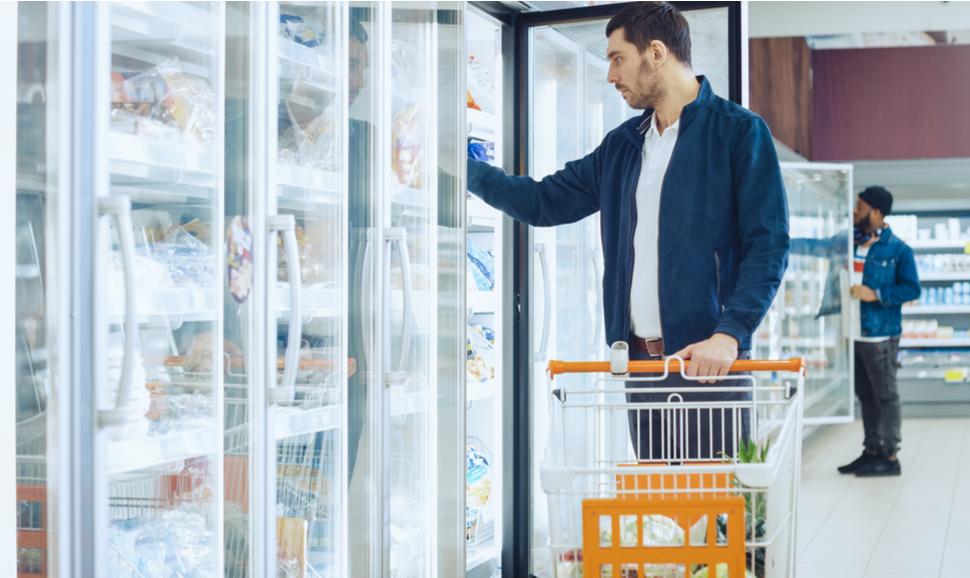Authors’ note: Ratio Institute taps Presidio Graduate School’s students and alumni for sustainability research in the food industry. Through our partnership, we’re able to communicate to a broader audience about best practices in engaging with the food industry around sustainability.
Today I went and looked inside my fridge — not for veggies, but for the label that specifies what kind of refrigerant my appliance uses to keep my veggies cold. The answer in my case is a hydrofluorocarbon (HFC) gas called R-134A. Most likely, your fridge uses the same stuff to absorb and dispense with heat. I encourage you to go take a look, because it turns out that refrigerants such as R-134A are powerful drivers of climate change. They’re also why your neighborhood grocery store is about to become ground zero for efforts to keep the planet cool.
HFCs are what the U.S. Environmental Protection Agency (EPA) calls high-Global Warming Potential (high-GWP) gases. Take R-134A, for instance. It has a GWP of 1,430, which means that a unit of the gas released into the atmosphere will, over 100 years, trap 1,430 times more heat than the same amount of CO2. My fridge happens to contain 5 ounces of R-134A. If all of that gas leaked out — which could happen at the end of the fridge’s life, if it’s improperly recycled — it would be the same as emitting nearly 450 pounds of CO2. That’s like driving a car from San Francisco to Boise. Basically, the air conditioners and fridges in our homes are small climate bombs.
But our personal appliances pale in comparison to what you might find in the beer aisle or frozen foods section of a grocery store. An average supermarket’s refrigeration system uses 3,500 pounds of a greenhouse gas that’s even more potent than R-134A. We also know that American grocery stores tend to leak about 25 percent of their refrigerant each year. Across all of the 38,000 supermarkets in the U.S., this means that the food retail sector is having a huge impact on the climate, producing annual emissions equivalent to almost 13 million cars or 15 coal-fired power plants.
R-134A has a GWP of 1,430, which means that a unit of the gas released into the atmosphere will, over 100 years, trap 1,430 times more heat than the same amount of CO2.
Fortunately, though, good news is on the horizon. Several states are working on phasing out HFCs and, in December, Congress passed a bill that will mostly eliminate the gases by 2036. Meanwhile, alternative technologies have matured so much that a growing number of supermarkets and other food retailers are stepping up to lead in implementing them. Between policy and competition on corporate sustainability, refrigerants are an area where the U.S. stands to achieve huge progress on climate, fast.
Some questions about the new legislation still need to be answered. For instance, we don’t know how exactly the EPA will implement an HFC phaseout. Will the agency use its existing mechanisms for regulating gases, or will it partly model its approach on HFC phaseout rules already in place in California and Europe?
Similarly, supermarkets and other businesses that are already moving to replace HFC refrigerants have struggled to choose the best alternative systems. A new class of synthetic chemicals known as HFOs are relatively cheap, but may have long-range problems; some research suggests the compounds could contribute to acid rain or eventually degrade and turn into potent climate forcers. In contrast, natural refrigerants — such as CO2, ammonia and certain hydrocarbons — have well-understood environmental effects and low Global Warming Potentials, but can be more difficult or expensive to implement.
However, these points of confusion shouldn’t slow business action on refrigerants. Smart food retailers are already getting ahead of legislation — and establishing themselves as sustainability leaders — in a few ways:
First, supermarkets and the like are getting better at maintenance and plugging leaks in their existing refrigeration systems. Addressing leaks can be more expensive than simply recharging refrigerants when they run out, but grocers large and small are already proving it’s possible to implement better practices in a cost-effective manner. For instance, the EPA recently recognized Weis Markets, which operates 192 stores across the Northeast, for driving its refrigerant leak percentage from 18.3 percent down to 7.2 percent over the course of a decade.
Supermarket companies can collaborate to bring down costs for alternative refrigerants, break down barriers to their implementation and scale the whole industry.
Food retailers can also lead by establishing meaningful HFC phaseout targets that move faster than legislation requires. Aldi is far and away the standard-bearer in the U.S. on this front. With many of its stores already running on natural refrigerants, the company has racked up hundreds of EPA GreenChill Platinum certifications. But other companies, from Whole Foods to Publix to Raley’s, are also making strides.
Finally, the largest supermarket companies can collaborate to bring down costs for alternative refrigerants, break down barriers to their implementation and scale the whole industry. An analog comes from the energy world, where corporate electricity buyers have worked together for more than a decade to help make solar and wind mainstream. The world needs a similar business effort on behalf of refrigerants, and organizations such as the North American Sustainable Refrigeration Council are already helping to pave the way.
Ratio Institute will also be helping supermarkets and other food retailers navigate the path to better refrigerants, starting with upcoming insights pieces that will detail forthcoming regulations and retrofit options for existing supermarkets. Now is the time for fridges that not only keep our food cold, but keep our planet cool, too.

